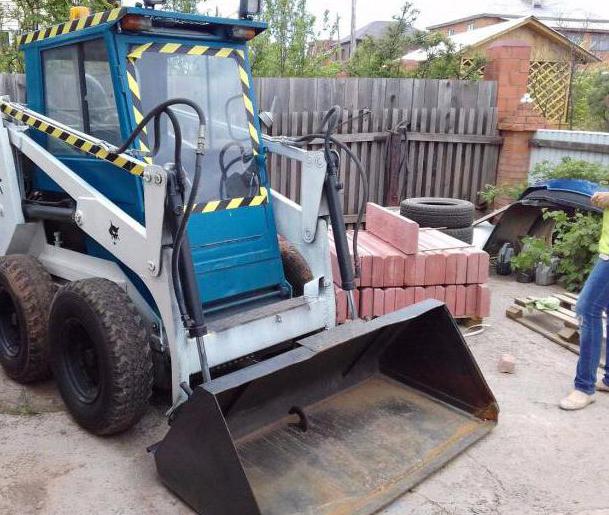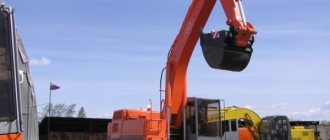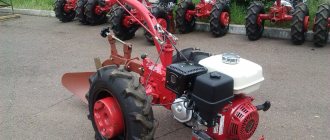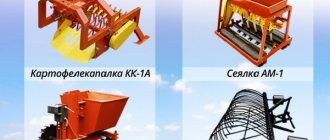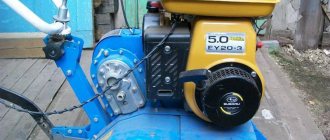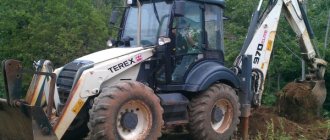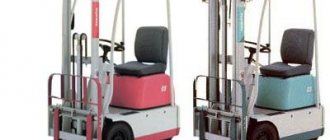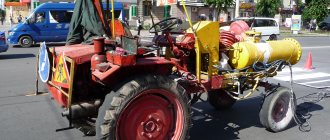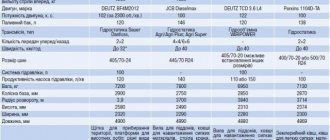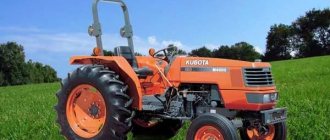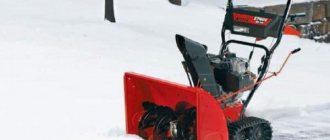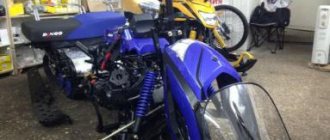The PUM-500 loader, also known as the “Beaver”, is a small-sized multifunctional machine that is designed to perform loading and unloading operations of bulk materials, as well as small-sized materials of the first, second, third and fourth density categories.
This loader is produced by the domestic manufacturer Uralvagonzavod, which is currently one of the leaders in the domestic market of small-sized special equipment. 90 percent of all products that are currently produced are occupied by the PUM-500 loader. This is explained by the fact that this machine is the most relevant among similar imported models, since it includes the same qualities, but the cost is slightly lower.
PUM-500 is most popular in organizations that are located in areas with moderate climatic factors. The machine is not demanding on temperature indicators and is capable of performing the necessary types of work with maximum efficiency even in frosts of minus 30 degrees and heat of plus 40 degrees. Comfort for the operator is ensured thanks to many cab design features.
The loader is equipped with a diesel two-cylinder power unit of the D-120-10 brand. The engine occupies a fairly small space, however, it is capable of developing a rated power of 22.1 kilowatts or 29.9 horsepower, which is enough for most jobs.
Purpose
The PUM-500 loader has a fairly wide range of applications, namely, it is used during the construction of any facilities, in industrial sectors, in various organizations, in forestry, as well as in public utilities. The following should also be noted:
- The machine can perform any loading and unloading work with piece cargo, as well as move them over certain distances and across warehouse territories.
- The loader copes well with loading and unloading various materials and soils, both bulk and small-sized ones. It can also work with the first, second, third and fourth categories of soil mass density.
- The equipment is capable of working in rather cramped workspace conditions. Most often these are warehouses. When used in construction, due to its small overall dimensions, the loader is capable of digging trenches in places inaccessible to other special equipment.
- In public utilities, PUM-500 is used to clear road surfaces, parks, parking lots, sidewalks and other similar areas from snow and various contaminants. In addition, the machine also copes with territory planning, thanks to the rather low specific pressure of the wheels on the ground, as this allows it not to damage the upper soil layers.
And this is not a complete list of the work it performs, since due to its compactness, the equipment can be used not only in standard conditions, but also in cramped ones, which significantly expands the range of work performed by this loader.
New loader of Uralvagonzavod PUM-500U
OJSC Scientific and Production Corporation Uralvagonzavod has released a new loader PUM-500U.
The universal small-sized skid steer loader PUM-500U is designed: for mechanization of loading and unloading operations with soil of categories I-IV (according to the appendix to GOST 17343-83), bulk and small-sized materials both in normal and cramped conditions; for transport and warehouse work with piece cargo; for special work (drilling wells, clearing snow and dirt from roads and sidewalks, etc.).
PUM-500U loaders can be used in areas with a temperate climate in the temperature range from minus 30°C to plus 40°C.
Thanks to the hydraulic device, PUM series loaders can be equipped with a variety of quick-release equipment, while replacing passive attachments occurs within 1-2 minutes and does not require the operator to leave the cab. When installing active attachments, it is necessary to connect the quick couplers and hydraulic piping system of the loader.
PUM loaders can be used in industry, civil and road construction, public utilities and agriculture, railways, airports, sea and river ports, to perform various special and auxiliary work.
The main advantages of PUM-500U loaders: versatility of the work performed; compactness, small turning radius; high efficiency and productivity; optimal load capacity; comfortable and ergonomic operator’s workplace; safety and noise-proof cabin; high cross-country ability due to high ground clearance; large angle of climb; high stability due to low center of gravity; low fuel consumption; hydraulic control of travel and working equipment ensures ease of operation and reduces operator fatigue; smooth operation and operation of attachments; ease of maintenance; low operating costs and quick payback; extensive dealer and service network; high-quality warranty and post-warranty service; the ability to install caterpillar tracks for working on sand, snow, ice, etc.; ease of transportation.
Detailed information about PUM-500U loaders can be found on the website of JSC NPK Uralvagonzavod.
Attachments
The following attachments are available for the PUM-500 loader:
- Mounted forks. Designed for loading, unloading and moving various cargoes mounted on pallets, boxes and others. Mounted forks are used in warehouses. Installed at the front of the machine. The length of the forks is 1313 millimeters. The frame width is 603 millimeters. The frame height is 974 millimeters. The weight of the unit is 125 kilograms.
- Fork grip. It is also intended for loading, unloading and moving stacked cargo, moving bushes, cut branches, pipes and much more. Used in agriculture and public services. The length of the forks is 970 millimeters. The frame width is 770 millimeters. The height of the frame is 1500 millimeters. The width of the grip itself is 1350 millimeters. The fork weight is 200 kilograms. Installed at the front of the machine.
- Mounted road brush. Intended for cleaning sidewalks, various areas, courtyard areas, street and road areas from debris and various contaminants. Used in public utilities. The brush can be rotated by plus/minus 15 degrees. The width of the captured area is 1750 millimeters. The structural length of the unit is 1360 millimeters. The total width is 650 millimeters. The height of the unit is 1980 millimeters. The total weight of the road brush is 307 kilograms. Installed at the front of the machine.
- Mounted cleaning brush. Designed for cleaning sidewalks, various areas, courtyard areas, street and road areas from debris and various contaminants. Used in public utilities. The width of the captured area is 1500 millimeters. The structural length of the equipment is 1235 millimeters. The total width is 665 millimeters. The height is 1790 millimeters. The total weight of the road brush is 330 kilograms. Installed at the front of the machine.
- Snow plow. Designed for clearing road surfaces of snow, for leveling various surfaces, as well as for road work. Used in public services and construction of any objects. The width of the captured area is 1700 millimeters. The mass of the snow plow is 243 kilograms. Installed at the front of the machine.
- Mounted rotary snow blower. Intended for cleaning sidewalks, street and road areas, courtyard areas, construction sites, as well as industrial facilities from large amounts of snow. Used in public utilities. The width of the captured area is 1650 millimeters. The maximum height of snow that this unit can handle is 250 millimeters. The maximum distance for throwing snow mass is 3150 millimeters. The structural length is 1420 millimeters. The width is 1130 millimeters. The total height is 1705 millimeters. The weight of the mounted rotary snow blower is 270 kilograms. Installed at the front of the machine.
- Mounted bucket without teeth. Intended for planning the surface of construction sites, as well as for doing any work with bulk and small-piece cargo belonging to the first, second, third and fourth density categories. There are three options in total, with a volume of 380 cubic millimeters, 500 cubic millimeters and 600 cubic millimeters. The weight of a bucket with a volume of 380 cubic millimeters is 160 kilograms. Installed at the front of the machine.
- Mounted bucket with teeth. Designed for working with sand; crushed stone; peat; soil of the first, second, third and fourth density categories. Used in industrial sectors and construction of any objects. The volume of this equipment is 200 cubic millimeters. Load capacity is designed for all loads not exceeding 500 kilograms. There are six teeth. The weight of the bucket is 155 kilograms. Installed at the front of the machine.
- Excavator attachments. Designed for digging trenches and small pits. Used in the construction of any objects. There is a bucket with a volume of 62 cubic millimeters. The largest digging radius is 2500 millimeters. The maximum angle of rotation of the boom is 110 degrees. It will take no more than 20 seconds to complete a full operating cycle. The weight of the excavator equipment is 540 kilograms. Installed at the front of the machine.
- Mounted hydraulic drill. Designed for drilling various holes up to one meter deep. Used in construction. The diameter of the drilled hole is 280 millimeters. The weight of the mounted hydraulic drill is 220 kilograms. It is controlled by special levers located in the cab of the machine. Installed at the front of the machine.
- Mounted concrete mixer. Intended for the preparation of building mixtures. It is used in the construction of any objects, garages, as well as in repair work. The maximum capacity of the concrete mixer is 100 liters. The volume of the finished concrete mixture is 25 liters. The recommended operating temperature of this equipment is not lower than plus 5 degrees. The structural length is 1065 millimeters. The total width is 1290 millimeters. The height is 1230 millimeters. The weight of the ready-to-use equipment is 195 kilograms. Installed at the front of the machine.
- Mounted welding machine. Designed for metal welding. Used in construction, utilities and industrial organizations. The smallest supplied welding current is 35 amperes. The highest supplied current is 180 amperes. The rated voltage of the welding current is 30 volts. The nominal welding cycle time is 5 minutes. Installed at the front of the machine.
In addition, the PUM-500 loader can be equipped with a caterpillar belt, which allows you to perform the necessary types of work on viscous soil and slippery surfaces (ice and snow). The width of the track is 326 millimeters. The caterpillars weigh 95 kilograms.
Modifications
This loader is available in two versions, namely PUM-500 (basic) and PUM-500U (modified). The PUM-500U modification differs from the basic loader only in the power plant. A Hatz 2M41 two-cylinder diesel unit is installed. The maximum output power is 23.7 kilowatts or 31.27 horsepower. In one minute, the crankshaft makes 2000 revolutions in nominal mode. Proper operation of this engine is observed even when operating in rather difficult weather conditions. Externally, the PUM-500U modification is completely similar to the basic loader.
UVZ PUM-500U, 32 hp, automatic transmission, 1990 — steering malfunctions
contents .. 1039 1040 1041 ..Basic steering faults
Sign
| Probable Cause | Elimination method | |
| Increased free play of the steering wheel | The connection in the universal joint is loose | Tighten |
| Steering gear bolts are not tightened securely | Tighten the bolts | |
| Excessive play or wear in the tie rod end | Replace the tie rod end | |
| The steering wheel is difficult to turn | Insufficient belt tension | Adjust the belt tension |
| Belt damage | Replace the belt | |
| Add liquid | Low fluid level | |
| Air in liquid | Remove air from liquid | |
| Hoses are pinched or damaged | Position correctly or replace | |
| Insufficient pressure generated by the pump | Repair or replace pump | |
| Pressure control valve stuck | Replace |
| Sign | Probable Cause | Elimination method |
| The steering wheel is difficult to turn | Pressure control valve stuck | Replace |
| Internal leaks in the power steering pump | Replace damaged parts | |
| Excessive fluid leakage from the rack and pinion into the steering gear housing | Replace damaged parts | |
| Damage to steering gear housing or pressure control valve | Replace damaged parts | |
| The steering wheel does not return to its original position properly | The torque of the ball joint of the tie rod end is too high | Replace the tie rod end |
| Universal joint too tight | Adjust | |
| The inner tie rod joint or ball joint is difficult to turn | Lubricate or replace the ball joint | |
| The steering gear fastening in the bracket is loose | Tighten | |
| Worn steering shaft joints or body O-ring | Replace | |
| Damaged steering gear | Replace the steering gear | |
| Damaged steering gear bearing | Replace | |
| Hoses are kinked or damaged | Replace hoses | |
| Damaged pressure control valve | Replace | |
| Damaged power steering pump shaft bearing | Replace | |
| Extraneous noise during steering operation | Hissing sound in steering gear All power steering produces additional noise. One of the most common is a hissing sound when the steering wheel is turned while the vehicle is stationary. This sound will be most obvious when turning the steering wheel with the brake pedal depressed. There is no relationship between this noise and steering performance. Do not replace the valve unless the hissing noise becomes extreme. The new valve will also make some noise. | |
| Rumbling sound in steering gear | Play between hoses and car body | Properly route and secure the hoses |
| Steering gear is not secured | Secure the steering gear | |
| The tie rod end and/or ball joint are not secured | Tighten connections | |
| Worn tie rod end and/or ball joint | Replace | |
| Power steering pump noise | Low fluid level | Add liquid |
| Air in liquid | Remove air | |
| Pump mounting bolts are not tightened | Tighten the bolts | |
Power steering problems
| Possible causes of malfunction | Remedy |
| Increased free play of the steering wheel | |
| Loosening the rack stop adjusting screw | Tighten |
| Loosening the steering gear mounting bolts | Tighten |
| Loose or worn tie rod ball joints | Tighten fastenings or replace hinges |
| Stiff steering wheel rotation (insufficient reinforcement) | |
| Slipping of the power steering pump drive belt | Adjust belt tension |
| Damage to the pump drive belt | Replace belt |
| Insufficient working fluid level | Restore fluid level to normal |
| Air entering the hydraulic system - | Remove air |
| Kinked or damaged hoses | Remove kinks or replace hoses |
| Insufficient pressure of the hydraulic booster pump | Fix the problem or replace the pump |
| Distributor stuck | Replace |
| Increased internal leaks in the pump | Replace defective pump parts |
| Increased fluid leaks from the steering mechanism | Replace defective parts |
| Misaligned or damaged steering gear or distributor seals | Replace seals |
| Unclear return of the steering wheel to the center position | |
| Increased turning torque of ball joints of tie rod ends | Replace |
| Excessive tightening of the rack stop adjusting screw | Correctly tighten the screw |
| Difficulty turning internal joints and/or tie rod ends | Replace |
| Loosening the bolts securing the steering gear to the subframe | Tighten the bolts |
| Worn steering shaft universal joint and/or seal | Fix or replace |
| Deformation of the steering rack | Replace |
| Drive gear bearing damage | Replace |
| Kinked or damaged hoses | Remove kinks or replace hoses |
| Damage to the pressure control valve | Replace |
| Damage to the pump rotor shaft bearing | Replace bearing |
| Noise (knocking) in the steering | |
| Hoses touching the body | Route the hoses correctly |
| Loosening the steering gear bracket | Tighten the fastener |
| Loose tie rods and/or ball joints | Tighten the fastener |
| Worn steering rods and/or ball joints | Replace |
| Increased noise of the power steering pump | |
| Insufficient working fluid level | Restore fluid level to normal |
| Air entering the hydraulic system | Remove air |
| Loosening the pump mounting bolts | Tighten the bolts |
Troubleshooting steering without power steering
Increased free play of the steering wheel is possible for the following reasons: the presence of gaps in the hinges of the steering rods of the front wheels, a violation of the adjustment of the engagement of the worm and roller or their increased wear, wear of the bushings or the axis of the pendulum lever, loosening of the steering gear housing or the bracket of the pendulum lever. To determine the gaps in the steering rod joints, it is recommended that one person turn the steering wheel left and right with sharp movements, and the second person should touch or visually identify the gaps by pressing his fingers against the two parts connected by the hinges.
If one part of the connection moves and the other is stationary, then there is play; if both parts move simultaneously, then there is no play. You can also determine the play in the hinge joints by moving the rod with your hands in the longitudinal direction. If, for example, the longitudinal rod moves along with the bipod, then there is no play in the hinge joint. If even a small gap is detected in the hinge, it must be eliminated (replace the hinge).
Failure to adjust the engagement of the worm and roller or their increased wear is also determined when the steering wheel swings sharply (to the right and left from the middle position) by the appearance of knocking in the steering mechanism. You can do this directly by shaking the steering gear bipod with your hand. The malfunction is eliminated by adjusting the engagement of the worm and roller, and in case of significant wear, by replacing parts.
Wear of the bushings or the axis of the pendulum arm is determined by creaking and knocking noises when turning the wheels to the right and left, as well as when the pendulum arm directly swings up and down. The malfunction is eliminated by tightening the nut of the pendulum arm axis or replacing worn parts. Loose fastening of the steering gear housing and the pendulum arm bracket can be eliminated by tightening the corresponding bolts and nuts.
Stiff rotation of the steering wheel or jamming in the steering mechanism may be due to improper adjustment of the side clearance in the worm mesh, excessive tightening of the worm bearings, increased wear on the roller or worm, bent steering rods, insufficient oil in the steering gear housing, or thickening of the lubricant at low temperatures. air, low pressure in the tires of the front wheels.
If, when driving the car, you feel tight rotation of the steering wheel or jamming in the steering mechanism, then, first of all, you need to check the air pressure in the tires and the lubrication in the steering gear housing. Then check the condition of the steering rods. If the rods are bent, they must be straightened or replaced, and then the wheel toe must be adjusted. If the jamming does not disappear, you need to disassemble the steering mechanism and replace worn and damaged parts. Knocks in the steering have the same reasons as increased free play of the steering wheel. Their definition and methods of elimination were discussed above.
Lubricant leakage from the steering gear housing may occur due to wear of the bipod or worm shaft seal, loosening of the crankcase cover, or damage to the gaskets. The defect is eliminated by replacing worn oil seals or damaged gaskets, and tightening the cover bolts.
Specifications
Technical characteristics of UVZ PUM-500U / Ural Carriage Works in the body of a loader with a 32 hp engine, automatic transmission produced since 1990.
Basic data
- Start of production:
January 2005 - End of production:
in production
- Body:
loader
Engine
- Power, hp: 32
- Maximum speed, km/h: 11
Transmission
- Transmission: Automatic
Dimensions
- Length, mm: 3400
- Width, mm: 1565
- Height, mm: 2260
Other
- Fuel tank volume, l: 46
contents .. 1039 1040 1041 ..
Specifications
Dimensional data:
- Construction length – 3400 millimeters.
- The width at the edges of the wheels is 2260 millimeters.
- The height of the cabin roof is 1565 millimeters.
- Wheelbase – 928 millimeters.
- The track width of the front wheels is 1300 millimeters.
- The track width of the rear wheels is 1300 millimeters.
Operational values:
- Construction weight - 2760 kilograms.
- The maximum traction force is 12 kilonewtons.
- The maximum unloading height from the bucket is 1900 millimeters.
- The maximum speed of independent movement is 9 kilometers per hour.
- Load capacity – 500 kilograms.
- Fuel tank capacity is 46 liters.
- The hourly engine consumption is 258 grams of diesel fuel per kilowatt.
Technical characteristics of the PUM-500 loader
| General characteristics of the PUM-500 mini loader | |
| Load capacity kg | 500 |
| Max. travel speed, km/h | 9 |
| Overall dimensions and weight of PUM-500 in transport position: | |
| Length, mm | 3400 |
| Width, mm | 1565 |
| Height, mm | 2260 |
| Weight with bucket, kg | 2760 |
| Maximum height of bucket unloading, mm | 2150 |
| Loader cabin PUM-500 | |
| Type | closed, glazed with front door opening outwards |
| Loader engine PUM-500 | |
| Brand | D-120/ HATZ |
| Type | four-stroke |
| Fuel | diesel |
| Number of cylinders | 2 |
| Cooling | air |
| Operating power, kW | 22,1 |
| Crankshaft rotation speed, rpm | 2000 |
| Starting system | electric starter |
| Specific fuel consumption, g/kWh | 258 |
| Fuel tank capacity, l | 46 |
| Electrical system of the universal loader PUM-500 | |
| Type | single-wire |
| Voltage, V | 12 |
| Running mechanism PUM-500 | |
| Base, mm | 928 |
| Track, mm | 1300 |
| Turning radius along the outer edge of the bucket, mm | 2000 |
| Max. traction force, kN (kgf) | 120 (1200) |
| Chassis type | hydromechanical |
| Chassis formula | 4x4 |
| Hydraulic system of mini loader PUM-500 | |
| Type | open |
| Max. hydraulic system pressure of working equipment, mPa (kgf/sq.cm.) | 16 (160) |
| Max. running gear pressure, mPa (kgf/sq.cm.) | 28 (280) |
Order
Peculiarities
The working units and mechanical connections of this loader are located extremely conveniently, which ensures simple maintenance. The machine has wide wheel joints that provide low pressure on the top layer of soil. This is done so that the equipment can work on soils with low bearing capacity.
The versatility of the PUM-500 is explained by a fairly large number of different attachments that can be used in the workflow to achieve any goals. All available units do not cause any particular difficulties when changing, as they use convenient connections.
Also, when doing any work using a hydraulic system, you can adjust the working elements, which allows you to configure the equipment for a specific type of work performed. There is also a control system for running gears in accordance with the principle of hydro-mechanical action.
Engine
The PUM-500 mini-loader is equipped with a two-cylinder diesel power unit of the D-120-10 brand. The diameter of the two cylinders is 105 millimeters. The total volume of the cylinders is 2080 cubic milliliters. With such indicators, the engine develops a maximum power of 22.1 kilowatts or 29.9 horsepower. The engine is able to operate properly in frosts of minus 30 degrees and in heat of plus 40 degrees. In one minute, the crankshaft makes 2000 revolutions in nominal mode.
Video of loader operation
In the video you can see how a loader clears snow:
Special automotive equipment is a reliable and faithful assistant to a person in solving many household and industrial issues. With its help, you can transport goods, cultivate agricultural fields, and take part in public works. This article will review the PUM-500 loader, the technical characteristics of which will also be indicated.
